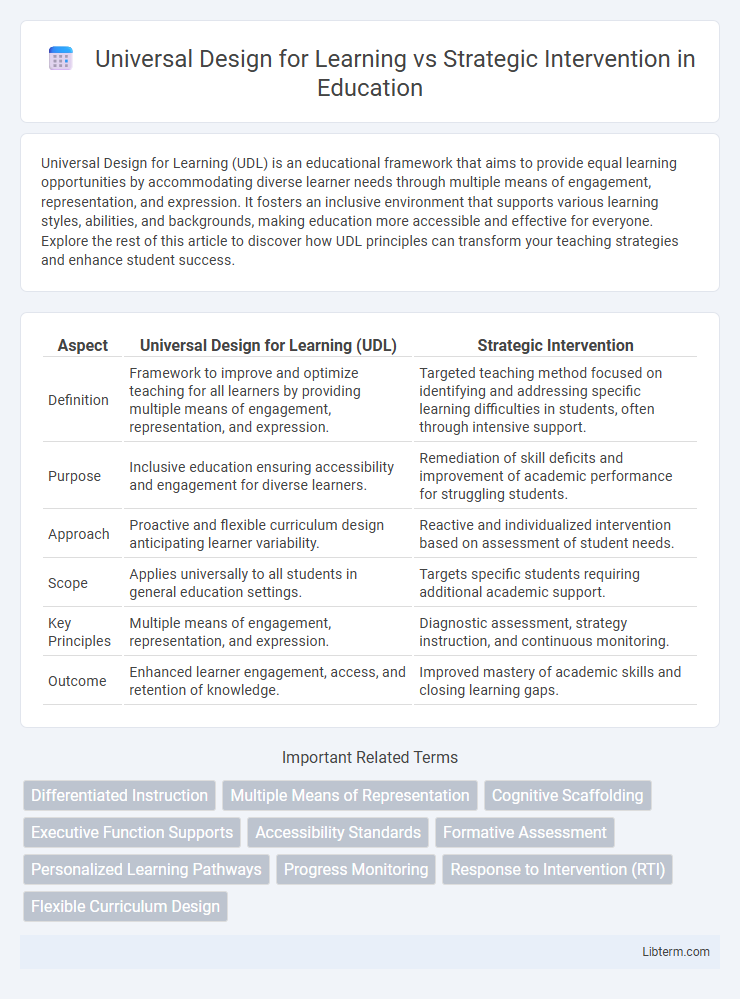Universal Design for Learning (UDL) is an educational framework that aims to provide equal learning opportunities by accommodating diverse learner needs through multiple means of engagement, representation, and expression. It fosters an inclusive environment that supports various learning styles, abilities, and backgrounds, making education more accessible and effective for everyone. Explore the rest of this article to discover how UDL principles can transform your teaching strategies and enhance student success.
Table of Comparison
| Aspect | Universal Design for Learning (UDL) | Strategic Intervention |
|---|---|---|
| Definition | Framework to improve and optimize teaching for all learners by providing multiple means of engagement, representation, and expression. | Targeted teaching method focused on identifying and addressing specific learning difficulties in students, often through intensive support. |
| Purpose | Inclusive education ensuring accessibility and engagement for diverse learners. | Remediation of skill deficits and improvement of academic performance for struggling students. |
| Approach | Proactive and flexible curriculum design anticipating learner variability. | Reactive and individualized intervention based on assessment of student needs. |
| Scope | Applies universally to all students in general education settings. | Targets specific students requiring additional academic support. |
| Key Principles | Multiple means of engagement, representation, and expression. | Diagnostic assessment, strategy instruction, and continuous monitoring. |
| Outcome | Enhanced learner engagement, access, and retention of knowledge. | Improved mastery of academic skills and closing learning gaps. |
Understanding Universal Design for Learning (UDL)
Universal Design for Learning (UDL) is an educational framework that emphasizes flexible learning environments to accommodate diverse learner needs by offering multiple means of engagement, representation, and expression. Unlike Strategic Intervention, which targets specific skill gaps through focused support, UDL proactively designs curriculum and instruction to reduce barriers and foster inclusivity for all students. Implementing UDL principles enhances accessibility and promotes equitable learning opportunities across varied educational settings.
Defining Strategic Intervention in Education
Strategic intervention in education refers to targeted instructional methods designed to address specific learning challenges and improve students' academic outcomes through personalized support and evidence-based strategies. It focuses on identifying individual learner needs and implementing precise actions to accelerate skill development and mastery. This approach contrasts with Universal Design for Learning, which emphasizes creating inclusive learning environments that proactively accommodate diverse learners from the outset.
Core Principles of Universal Design for Learning
Universal Design for Learning (UDL) centers on three core principles: multiple means of engagement, representation, and action/expression, ensuring diverse learners access and interact with content effectively. Strategic Intervention targets specific academic or behavioral challenges through targeted support rather than broad accessibility frameworks. UDL's emphasis on flexible learning environments promotes inclusivity by proactively addressing learner variability across all educational contexts.
Key Features of Strategic Intervention Strategies
Strategic Intervention Strategies emphasize targeted skill-building through diagnostic assessments and personalized instruction tailored to individual learner needs, ensuring measurable progress in academic performance. These strategies incorporate structured feedback, goal-oriented practice, and metacognitive techniques to enhance problem-solving and critical thinking abilities. Unlike Universal Design for Learning, which promotes broad accessibility and engagement, Strategic Intervention focuses intensely on remediation and skill mastery for learners facing specific academic challenges.
UDL vs Strategic Intervention: Conceptual Differences
Universal Design for Learning (UDL) emphasizes creating flexible learning environments that accommodate diverse learners by providing multiple means of engagement, representation, and expression. Strategic intervention targets specific learning deficits through tailored, intensive instruction designed to address individual student needs directly. While UDL seeks to proactively design curriculum for inclusivity, strategic intervention is reactive, focusing on remediating challenges after they arise.
How UDL Supports Inclusive Classrooms
Universal Design for Learning (UDL) supports inclusive classrooms by providing multiple means of representation, expression, and engagement, which accommodate diverse learning styles and abilities. This framework proactively removes barriers to learning by offering flexible methods and materials that meet the needs of all students, including those with disabilities and English language learners. By contrast, Strategic Intervention typically targets specific students after challenges arise, whereas UDL fosters an accessible environment that anticipates and addresses variability from the start.
Effectiveness of Strategic Interventions for Diverse Learners
Strategic interventions tailored to individual needs demonstrate significant effectiveness in supporting diverse learners by addressing specific skill gaps and learning challenges. Compared to Universal Design for Learning (UDL), which offers broad accessibility through flexible content delivery, strategic interventions provide targeted scaffolding and intensive support that can accelerate mastery in critical academic areas. Research indicates that combining UDL principles with strategic interventions optimizes engagement and achievement, particularly for students with disabilities or learning difficulties.
Practical Implementation: UDL in Everyday Teaching
Universal Design for Learning (UDL) integrates flexible teaching methods to accommodate diverse learning styles by providing multiple means of engagement, representation, and expression in everyday classrooms. Practical implementation of UDL includes designing lessons with varied materials, such as multimedia resources and interactive activities, to support student accessibility and motivation. Strategic intervention, while targeting specific learning gaps, complements UDL by offering tailored support based on continuous assessment, ensuring all students can achieve the curriculum goals effectively.
Targeted Approaches: When to Use Strategic Interventions
Strategic interventions are most effective when addressing specific learning deficits or challenges identified through targeted assessments within the Universal Design for Learning (UDL) framework. Unlike UDL's broad, proactive strategies aimed at all learners, strategic interventions focus on individualized support to remediate or accelerate skill development. These targeted approaches are essential for students who do not sufficiently benefit from UDL's multiple means of representation, engagement, and expression.
Integrating UDL and Strategic Interventions for Optimal Learning
Integrating Universal Design for Learning (UDL) and Strategic Interventions enhances educational inclusivity by providing multiple means of engagement, representation, and expression tailored to diverse learners' needs. Strategic interventions target specific learning gaps through focused, evidence-based techniques, while UDL offers a flexible framework accommodating varied learning preferences. Combining UDL's proactive design with targeted strategic interventions ensures optimal learning outcomes by addressing both universal accessibility and individualized support.
Universal Design for Learning Infographic

 libterm.com
libterm.com